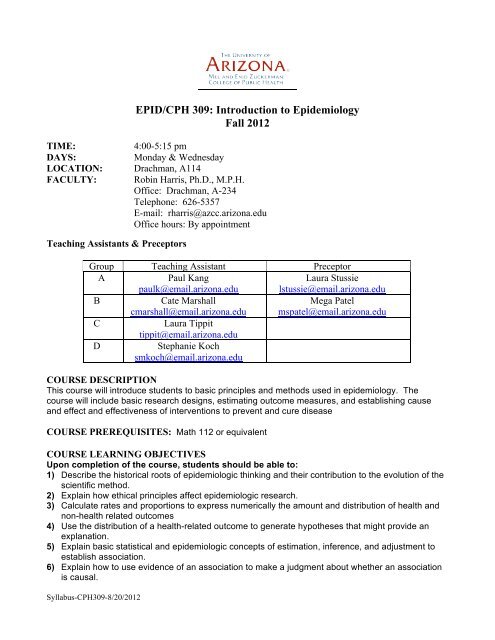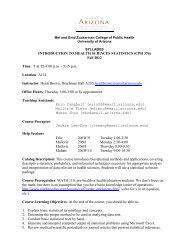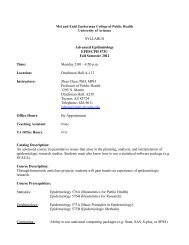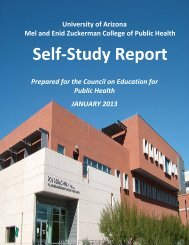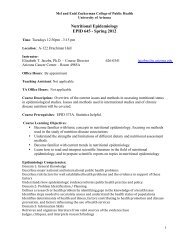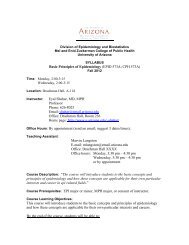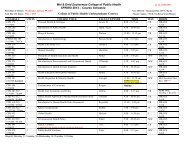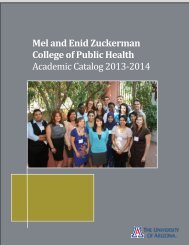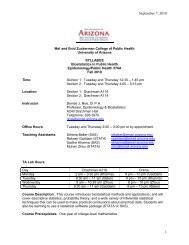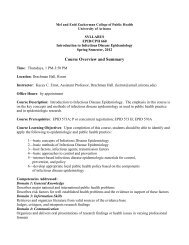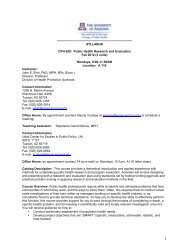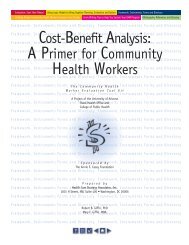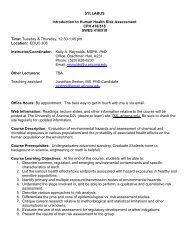CPH 309 Introduction to Epidemiology - Mel and Enid Zuckerman ...
CPH 309 Introduction to Epidemiology - Mel and Enid Zuckerman ...
CPH 309 Introduction to Epidemiology - Mel and Enid Zuckerman ...
You also want an ePaper? Increase the reach of your titles
YUMPU automatically turns print PDFs into web optimized ePapers that Google loves.
EPID/<strong>CPH</strong> <strong>309</strong>: <strong>Introduction</strong> <strong>to</strong> <strong>Epidemiology</strong>Fall 2012TIME:DAYS:LOCATION:FACULTY:4:00-5:15 pmMonday & WednesdayDrachman, A114Robin Harris, Ph.D., M.P.H.Office: Drachman, A-234Telephone: 626-5357E-mail: rharris@azcc.arizona.eduOffice hours: By appointmentTeaching Assistants & Precep<strong>to</strong>rsGroup Teaching Assistant Precep<strong>to</strong>rAPaul Kangpaulk@email.arizona.eduLaura Stussielstussie@email.arizona.eduBCate Marshallcmarshall@email.arizona.eduMega Patelmspatel@email.arizona.eduCLaura Tippittippit@email.arizona.eduDStephanie Kochsmkoch@email.arizona.eduCOURSE DESCRIPTIONThis course will introduce students <strong>to</strong> basic principles <strong>and</strong> methods used in epidemiology. Thecourse will include basic research designs, estimating outcome measures, <strong>and</strong> establishing cause<strong>and</strong> effect <strong>and</strong> effectiveness of interventions <strong>to</strong> prevent <strong>and</strong> cure diseaseCOURSE PREREQUISITES: Math 112 or equivalentCOURSE LEARNING OBJECTIVESUpon completion of the course, students should be able <strong>to</strong>:1) Describe the his<strong>to</strong>rical roots of epidemiologic thinking <strong>and</strong> their contribution <strong>to</strong> the evolution of thescientific method.2) Explain how ethical principles affect epidemiologic research.3) Calculate rates <strong>and</strong> proportions <strong>to</strong> express numerically the amount <strong>and</strong> distribution of health <strong>and</strong>non-health related outcomes4) Use the distribution of a health-related outcome <strong>to</strong> generate hypotheses that might provide anexplanation.5) Explain basic statistical <strong>and</strong> epidemiologic concepts of estimation, inference, <strong>and</strong> adjustment <strong>to</strong>establish association.6) Explain how <strong>to</strong> use evidence of an association <strong>to</strong> make a judgment about whether an associationis causal.Syllabus-<strong>CPH</strong><strong>309</strong>-8/20/2012
ProjectsThere are two projects <strong>to</strong> be completed throughout the semester: 1) review of a survey questionnaire,<strong>and</strong> 2) data hunt. Specific instructions for the format <strong>and</strong> grading criteria of these projects will beprovided. Check the online website for further details. Due dates for the projects are listed on thecourse schedule.An extra credit project is available for students <strong>to</strong> complete if so interested. The assignment is worth 5extra points <strong>to</strong> the overall points of the course. Instructions are available on the website. Thisassignment can be completed at any time, but must be submitted before last day of class.ExaminationsThe midterm <strong>and</strong> final examination will be closed book, in-class exams unless otherwise specified.The final can potentially be an online exam. Students will be allowed <strong>to</strong> bring in 1 page of notes <strong>and</strong>calcula<strong>to</strong>rs <strong>to</strong> an in-class exam.STUDENT EVALUATIONEvaluation will be based upon the student's ability <strong>to</strong> demonstrate a basic underst<strong>and</strong>ing of theconcepts, principles, <strong>and</strong> methods of epidemiology through:GRADING SCHEMEMidterm 20 %Homework 25%Class Participation 5%Project 1: Questionnaire review 10%Project 2: Data Hunt 15%Final Exam 25%Total 100%The final grades are based on the following point system, although the instruc<strong>to</strong>r reserves the right <strong>to</strong>revise this scale if necessary.A - 91-100%D - 61-70%B - 81-90%E -
Academic Integrity: All UA students are responsible for upholding the University of Arizona Code ofAcademic Integrity, available through the office of the Dean of Students <strong>and</strong> online: The official policyfound at:http://dos.web.arizona.edu/uapolicies/scc5308abcd.html <strong>and</strong>http://dos.web.arizona.edu/uapolicies/cai1.html.Plagiarism: What counts as plagiarism?• Copying <strong>and</strong> pasting information from a web site or another source, <strong>and</strong> then revising it so thatit sounds like your original idea.• Doing an assignment/essay/take home test with a friend <strong>and</strong> then h<strong>and</strong>ing in separateassignments that contain the same ideas, language, phrases, etc.• Quoting a passage without quotation marks or citations, so that it looks like your own.• Paraphrasing a passage without citing it, so that it looks like your own.• Hiring another person <strong>to</strong> do your work for you, or purchasing a paper through any of the on- oroff-line sources.Classroom Behavior: Participation is an important component of this class. Feel free <strong>to</strong> ask plenty ofquestions, <strong>and</strong> contribute your own ideas <strong>and</strong> knowledge <strong>to</strong> the class. It is important <strong>to</strong> read thematerial in advance <strong>and</strong> give it some careful thought, so that you come <strong>to</strong> class prepared <strong>to</strong> discussinformation <strong>and</strong> opinions. Engaging <strong>and</strong> instructive class discussion can come from this if we are bothprepared beforeh<strong>and</strong> <strong>and</strong> mutually respectful during our interactions with each other. Talking, usingelectronic devices such as cell phones, lap<strong>to</strong>ps, or ipods, <strong>and</strong> any other unruly behavior thatdisrupts the class will not be <strong>to</strong>lerated. The instruc<strong>to</strong>r reserves the right (<strong>and</strong> obligation <strong>to</strong> theclass) <strong>to</strong> administratively drop from the course any student who does not maintain appropriatebehavior. Turn off your cell phones.Students are expected <strong>to</strong> be familiar with the UA Policy on Disruptive Behavior in an InstructionalSetting found at http://web.arizona.edu/~policy/disruptive.pdf <strong>and</strong> the Policy on Threatening Behaviorby Students found at http://web.arizona.edu/~policy/threatening.pdfGrievance Policy: Should a student feel he or she has been treated unfairly, there are a number ofresources available. With few exceptions, students should first attempt <strong>to</strong> resolve difficulties informallyby bringing those concerns directly <strong>to</strong> the person responsible for the action, or with the student'sgraduate advisor, Assistant Dean for Student <strong>and</strong> Alumni Affairs, department head, or the immediatesupervisor of the person responsible for the action. If the problem cannot be resolved informally, thestudent may file a formal grievance using the Graduate College Grievance Policy found athttp://grad.arizona.edu/catalog/policies/academic-policies/grievance-policyGrade Appeal Policy: http://catalog.arizona.edu/2008%2D09/policies/gradappeal.htmSyllabus Changes: Information contained in the course syllabus, other than the grade <strong>and</strong> absencepolicies, may be subject <strong>to</strong> change with reasonable advance notice, as deemed appropriate.Please Note: URLs change frequently. You will need <strong>to</strong> test the URLs in the syllabus youproduce each semester, <strong>to</strong> ensure the links are correct.Syllabus-<strong>CPH</strong><strong>309</strong>-8/20/2012
MondayNovember 5WednesdayNovember 7MondayNovember 12WednesdayNovember 14MondayNovember 19WednesdayNovember 21MondayNovember 26WednesdayNovember 28MondayDecember 3WednesdayDecember 5MondayDecember 10Threats <strong>to</strong> Validity: ConfoundingEpi & Policy – Screening for Disease Chapter 7Homework #7dueVeterans’ Day – no classInfectious Diseases & OutbreaksKristen Pogreba-Brown, MPHID Epi – Outbreaks continuedIn class/discussionUsing epi methods <strong>to</strong> underst<strong>and</strong> whyvaccine rates are low?Steve Haenchen, MPHAsthma & Respira<strong>to</strong>ry <strong>Epidemiology</strong>Janet Rothers, PhDSpecial Topics: Injury <strong>Epidemiology</strong>Jerry Poplin, MSDiscussion <strong>and</strong> ReviewFinalChapter 8Homework #8 dueHomework #9 dueProject #2 dueChapter 10*Chapter numbers refer <strong>to</strong> required text – <strong>Epidemiology</strong> 101.Syllabus-<strong>CPH</strong><strong>309</strong>-8/20/2012


